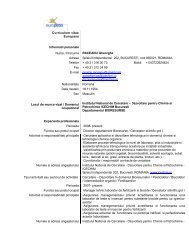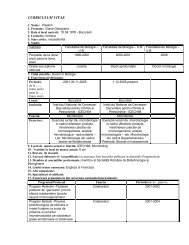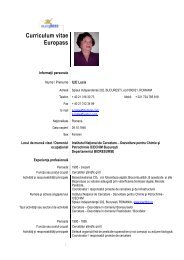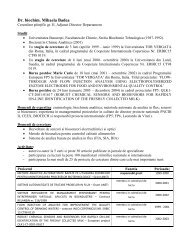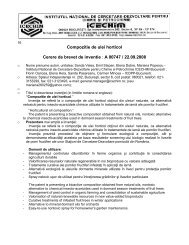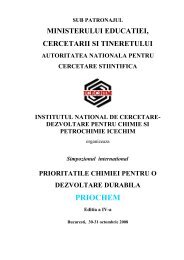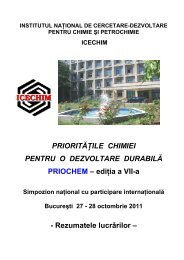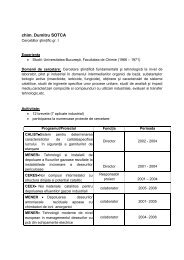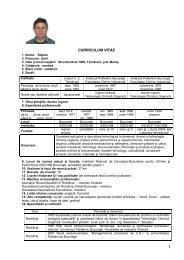INSTITUTUL NAÅ¢IONAL DE CERCETARE-DEZVOLTARE - ICECHIM
INSTITUTUL NAÅ¢IONAL DE CERCETARE-DEZVOLTARE - ICECHIM
INSTITUTUL NAÅ¢IONAL DE CERCETARE-DEZVOLTARE - ICECHIM
- No tags were found...
You also want an ePaper? Increase the reach of your titles
YUMPU automatically turns print PDFs into web optimized ePapers that Google loves.
4 - Protection and Environmental Engineering - PTreatment of textile wastewater containing direct and active dyes in the presence of anionicsurfactants and Ethylene glycolGONŢA Maria, Duca Gheorghe, Matveevici Vera, Mocanu Larisa, Iambartev VioricaMoldova State Universit, Departament of Industrial and Ecological ChemistryIt was studied the textile dyes lower concentrations dye active RA (active red) and PA(orange active) in model solutions with initial concentration 50 mg/l in the presence ofsurfactant anonymous (sodium lauryl sulfate), concentration of which varies from 20 mg/l to60 mg/l and their combined treatment with coagulant (aluminum sulfate), followed by theiradsorption by active coal.It was established that RA dye is removed from model solutions up to health standards(by value of chemical oxygen demand COD-Cr = 5,0-8.0mgO/l) in the presence of anionicsurfactant with C.init .= 20 mg/l only to their treatment with aluminum coagulant. Withincreasing surfactant concentration up to 40-60mg/l concentration of organic substancesremaining after COD-Cr value is greater than the allowable. The most effective wayto removeRA dye and surfactant amestecl by the method, when the concentration ratio RA: surf. = 1:1.With increasing surfactant concentration dye vs. RA (C(RA) =50mg/l and C.surf .= 60 mg/l),the effect of their adsorption by active carbon decreases, but the concentration of COD-Crremaining after the adsorption, is within acceptable limits.To achieve the proposed tasks coagulation process was studied catalytic oxidationfollowed by ethylene glycol (EGL) or adsorption. Further coagulation and oxidation wasstudied textile dyes directly lit red (RAD), blue light directly (AAL) in the presence of EGLin model solutions using aluminum sulfate and Fenton reagents depending on the coagulantconcentration, hydrogen peroxide, the concentration of iron (II ) and during treatmentThe coagulation process of textile dyes studied in the presence of EGL.It has beendetermined that COD-Cr decreases from 65mgO/l up to 10.6mgO/l (50mg/l or AAL-RADand 30mg/l EGL). With increasing dye concentration and EGL (100 mg/l, 200mg/l for dyesand 30mg/l 60 mg/l for EGL) COD-Cr coagulation after reaching 15.6 mgO/l. It was foundthat adsorption or oxidation processed after coagulation did not lead to effective treatment ofthese systems.By optimizing the process of oxidation in the presence of direct dyes EGL for the samerange of concentrations (50mg/l or AAL-RAD and 30 mg /l EGL) the CCO-Cr has decreasedup to 10.0 mgO/l, and after adsorption has reached 3 mgO/l, which also corresponds to theCMA for COD.




